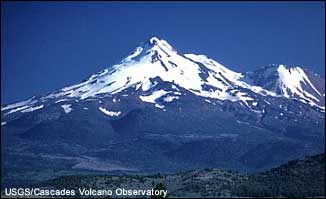Plate Boundaries
Shield volcanoes are almost exclusively basalt, a type of lava that is very fluid when erupted. For this reason these volcanoes are not steep. Eruptions at shield volcanoes are only explosive if water somehow gets into the vent. Shield volcanoes may be produced by hot spots which lay far away from the edges of tectonic plates. Shields also occur along the mid-oceanic ridge, where sea floor spreading is in progress and along subduction related volcanic arcs.



Divergent- occur along spreading centers where plates are moving apart and new crust is created by magma pushing up from the mantle. divergence along the mid-Atlantic ridge causes the Atlantic Ocean to widen about 2 centimeters per year.

Convergent- Convergent plate boundaries are locations where lithospheric plates are moving towards one another. The plate collisions that occur in these areas can produce earthquakes, volcanic activity and crustal deformation. When a convergent boundary occurs between two oceanic plates one of those plates will subduct beneath the other.

Transform- Transform Plate Boundaries are locations where two plates slide past one another. The fracture zone that forms a transform plate boundary is known as a transform fault. Most transform faults are found in the ocean basin and connect offsets in the mid-ocean ridges. A smaller number connect mid-ocean ridges and subduction zones.


Convergent- Convergent plate boundaries are locations where lithospheric plates are moving towards one another. The plate collisions that occur in these areas can produce earthquakes, volcanic activity and crustal deformation. When a convergent boundary occurs between two oceanic plates one of those plates will subduct beneath the other.

Transform- Transform Plate Boundaries are locations where two plates slide past one another. The fracture zone that forms a transform plate boundary is known as a transform fault. Most transform faults are found in the ocean basin and connect offsets in the mid-ocean ridges. A smaller number connect mid-ocean ridges and subduction zones.

Shield volcanoes are almost exclusively basalt, a type of lava that is very fluid when erupted. For this reason these volcanoes are not steep. Eruptions at shield volcanoes are only explosive if water somehow gets into the vent. Shield volcanoes may be produced by hot spots which lay far away from the edges of tectonic plates. Shields also occur along the mid-oceanic ridge, where sea floor spreading is in progress and along subduction related volcanic arcs.
A stratovolcano also has steep sides with a distinguishing cone shape and is frequently composed of several different vents that erupt lava, sometimes in different ways. Pyroclastic flows*, lava domes**,and cinder cones sometimes characterize stratovolcanoes. Usually, these types of volcanoes erupt explosively and violently, sometimes completely blowing their tops!

A cinder cone is a steep, conical hill of volcanic fragments that accumulate around and downwind from a vent. Cinder cones range in size from tens to hundreds of meters tall.
The Pacific Ring of Fire is an area of frequent earthquakes and volcanic eruptions encircling the basin of the Pacific Ocean. In a 40,000 km horseshoe shape, it is associated with a nearly continuous series of oceanic trenches, volcanic arcs, and volcanic belts and/or plate movements. The Ring of Fire has 452 volcanoes and is home to over 75% of the world's active and dormant volcanoes.




No comments:
Post a Comment